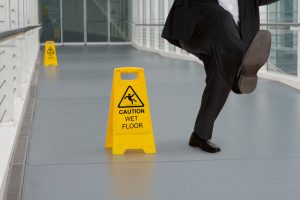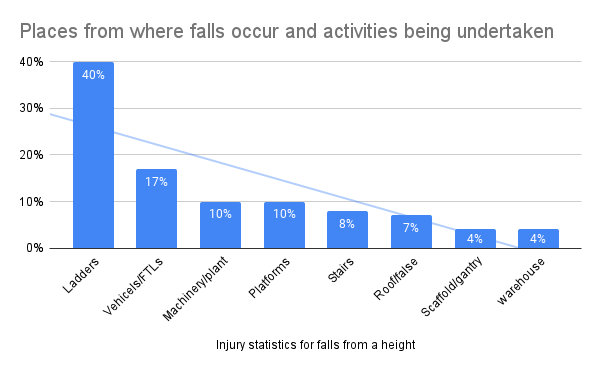Have you been involved in an accident at work that has caused you an injury? Maybe you have had a slip and fall and are wondering if you can claim compensation. This article will guide you through the claims process and help you understand what kind of slip and fall settlements are awarded in personal injury claims for accidents at work.
All employers have a duty of care and we will explain what is expected from them. If you have any questions at all about slip and fall at work settlements why not contact our team of expert advisors?
- Call 0800 408 7825
- Use our contact form to get in touch
- Or our live chat service
Select A Section
- Examples Of How To Claim Slip And Fall At Work Settlements
- Examples Of How Slips And Falls At Work Happen
- What Injuries Could Slips And Falls At Work Cause?
- Employers Duty Of Care To Prevent Slips And Falls
- Examples Of Slip And Fall At Work Settlements
- Discuss No Win No Fee Terms With Our Team
What Are Examples Of Slip And Fall At Work Settlements?
Accidents at work can happen for all types of reasons. You may have had a fall at work and are wondering whether you could claim for slip and fall at work settlements. If you are considering whether to claim for a slip and fall you have had at work it may be a good idea to firstly check whether your claim is valid.
There are many health and safety at work laws in this country. They place a duty of care on employers to ensure that workplaces are as safe as can be reasonably expected. To be eligible for slip and fall settlements after an accident at work you must be able to show that your employer has acted negligently. Have they breached this duty of care? Furthermore, it is essential to be able to prove that this breach in duty led to you suffering an injury.
What Type of Hazards Could Lead To Slip and Fall Settlements?
- Wet floor
- Slippery floor
- Broken floor
- Damaged floor
- Poor lighting
- Trip hazard
How Common Are Slips And Falls At Work?
The graph below was taken from the Health and Safety Executive website. It shows how falls from height in the food and drink industries happen. Investigated for three years by the Health and Safety Executive (HSE) this graph illustrates the percentage of where falls from height occur.
Examples Of How Slips And Falls At Work Happen
Slips and falls could happen causing a workplace accident . There are many hazards that could cause this type of accident. Injuries that result could range from minor to severe and even death. Slip, trip and falls are the most common type of accident in the workplace when looking at non-fatal injuries. This type of accident caused 33% of non-fatal injuries in the workplace during 2020/21. They are also the most common cause of major injury in the workplace – according to the HSE in 95% of serious slip and fall accidents the worker suffered a fractured bone.
Slip and fall at work settlements could be awarded if an employee can show that their accident was caused by negligence. It will mean that whatever injury they suffered could have been avoided. Here are some examples that could prevent an injury at work from a slip and fall happening:
- Cleaning any spills straight away
- Wet floor signs where needed
- Clearing away any debris from the floors
- Always keep walkways clear from hazards or clutter
- Making sure any wires are secure, tacking, taping etc
- Keeping filing cabinets or storage draws closed after use
What Injuries Could Slips And Falls At Work Cause?
A slip and fall injury at work could range from something mild to something really serious depending on the cause or the way you landed. There are many reasons why these accidents could happen and result in lots of different injuries.
Some of the more common types of injuries could be, fractures and dislocated joints to the ankle, wrist, fingers, knee and shoulder. Bruises, sprains and cuts, burns and scalds are also quite common in several cases. In more severe cases, head injuries, spinal cord damage or death could potentially occur.
Employers Duty Of Care To Prevent Slips And Falls
Under The Health and Safety at Work etc. Act 1974 all employers have a duty of care to ensure the health and safety and welfare of all employees and anyone affected by their work in as much as can be expected.
It is useful to know your rights. The workplace should be kept reasonably safe and without risks to health. Where risks cannot be removed they should be reduced. Training and supervision is a must. This is to ensure all staff are aware of procedures and know how to prevent slips and falls and the causes.
Walkways should also be kept clear at all times, removing any hazardous objects and any wet floors mopped up straight away leaving out a wet floor sign.
Our advisors are waiting to take your call. They can answer any of your questions regarding slip and fall at work settlements. They will even offer to assess your case to see if you have a valid claim.
If you’d like to learn more about what to do after a workplace accident, head here to read our comprehensive guide.
It’s important to take action in good time after the accident if you do wish to claim compensation. There is a time limit for slip and fall claims, which is just 3 years from the date of the accident. To learn more, check out our comprehensive guide here.
Examples Of Slip And Fall At Work Settlements
How much compensation for a slip accident at work? It can be quite complex when calculating slip and fall at work settlements. Each and every case for personal injury is unique. Your case may share similar characteristics to other claims but ultimately it will have unique aspects. That is why it is impossible to give average amounts.
All slip and fall at work settlements would be calculated firstly by general damages. These damages would be worked out by the suffering, the pain and length which these injuries last and the loss of amenity.
Secondly, special damages would be worked out from any loss of earnings or losses you have encountered or expenses you have had to pay due to your injuries.
Using the Judicial College Guidelines (JCG) a publication showing different types of injuries along with compensation brackets we have created the table below.
If you have an injury other than any shown in the table below, please call us for further guidance and we will be happy to help. We can estimate your injuries for you, using these guidelines.
| Injury | Addition details | Compensation |
|---|---|---|
| Head Injuries | Very Severe Brain Damage | £264,650 to £379,100 |
| wrist Injuries | Injuries causing loss of function in the wrist. | £44,690 to £56,180 |
| Ankle Injuries | Severe soft-tissue damage resulting in deformity or below-knee amputation | £46,980 to £65,420 |
| Toe Injuries | Amputation of All Toes | £34,270 to £52,620 |
| Back Injuries | Damage to the spinal cord and nerve roots, leading to serious injuries. Causing severe pain and disability and possibly incomplete paralysis | £85,470 to £151,070 |
| Hand Injuries | Amputation of Index and Middle and/or Ring Fingers | £58,100 to £85,170 |
| Work-Related Upper Limb Disorders | Continuing bilateral disability with surgery and loss of employment. | £20,560 to £21,700 |
| Achilles Tendon | Where the tendon has been repaired but there is residual weakness, a limit of ankle movements, a limp, and residual scarring and where further improvement is unlikely. | £23,460 to £28,240 |
| Knee Injuries | Injury to the joint, lengthy treatment, considerable pain and loss of function. | £65,440 to £90,290 |
| Damage to the teeth | Loss or serious damage to front teeth. | £8,200 to £10,710 |
Also as part of your claims process you may be required to attend a medical assessment. This would be by a medical professional who would assess all of your injuries and make up a report for your solicitor who would use this report alongside the Judicial College Guidelines to have a clear guide of the compensation you deserve.
Discuss No Win No Fee Terms With Our Team
Our team of advisors are experienced when it comes to slip and fall at work settlements. They have the knowledge to know if you have a valid claim or not. They can guide you through the process of what evidence you would need and your next steps if you should wish to submit a claim.
If they think your case is valid they will offer to connect you with our panel of No Win No Fee solicitors.
This means you will have no upfront solicitor costs. If your claim was not successful there are no solicitor fees to pay. Alternatively if your case wins then you would pay a success fee. All the terms and conditions would be in a Conditional Fee Agreement.
If you are wanting to know more about slip and fall at work settlements and wondering if you are entitled to claim, please contact our advisors today on any of the below:
- Call 0800 408 7825
- Use our contact form to get in touch
- Or our live chat service
Further Information On Slip And Fall At Work Settlements
This article will help if you have suffered a back injury at work
If your injury is minor this guide will explain if you can claim.
An explanation of loss of wages
The Health and Safety Executive has further information on falls from height.
Read this NHS page on falls and prevention
Check this page on Citizens Advice regarding personal injury claims.


